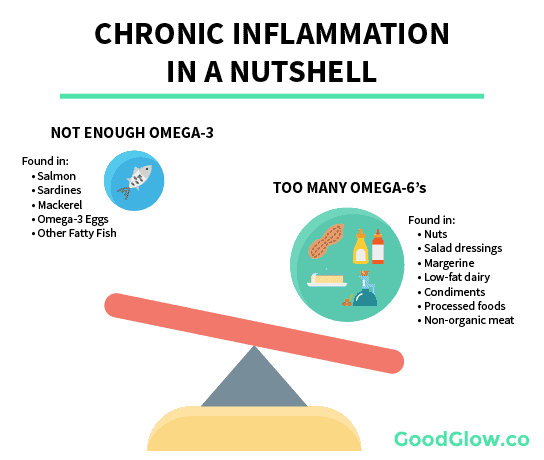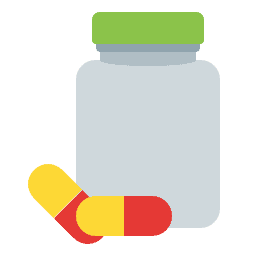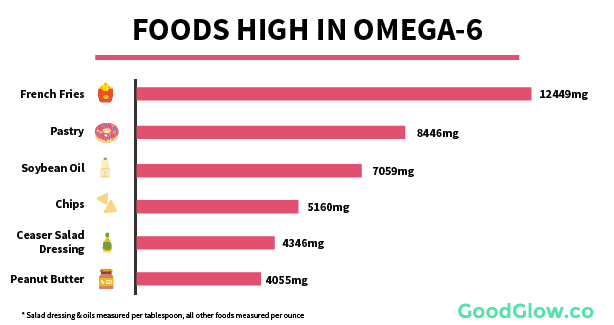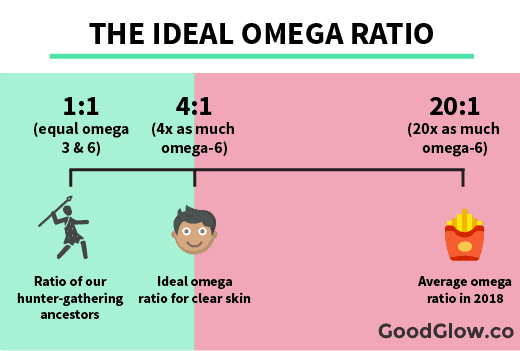Sardines are a legitimate superfood due to their omega-3 fatty acid content, high protein content, and low carbohydrates.
I never realized how expensive fresh fish was until I started my low inflammation diet. I’d eat salmon once every few weeks, but I was primarily getting my omega-3s (the good fats found in fish oil) from supplements.
Despite the supplements, I still had the tell-tale signs of chronic inflammation – pain in my joints, dry skin, and plenty of angry pimples.
One day at the grocery store I stumbled upon a can of sardines advertising their high omega-3 content. Omega-3s are a fatty acid found in fish that keep our immune systems running properly.
At $2 a can it didn’t hurt to try em’ out, and much to my surprise the next day my skin looked noticeably better. So, I continued my habit of eating at least two sardines a day.
The results were pretty incredible. The number of inflamed, angry, red pimples diminished greatly – and best yet, I wasn’t breaking the bank on seafood. After doing a little research, I found that not only are sardines a great source of omega-3s, but also other vitamins and nutrients that truly make a superfood. In fact, there really aren’t many foods that are as inexpensive and nutritionally dense as sardines.
Why are Sardines a Superfood for Your Skin?
Sardines are loaded with omega-3 fatty acids, which help reduce inflammation, improve cardiovascular health, and regulate sebaceous oil production.
Trust me – you need more omega-3s.
A single serving of sardines (about 2 whole sardines) contains over 1,000mg of omega-3 fatty acids, including 670mg of EPA and 722mg of DHA. That’s right on-par with the omega-3 content found in the king of all acne-fighting meat – wild-caught salmon. A single serving of sardines contains 3 times more omega-3 fatty acids than you’d find in the average fish oil pill. For the cost, you really can’t find a better food source of omega-3s.

Sardines are also an excellent source of vitamin D, protein, potassium, and vitamin B12. Best of all? They have zero carbs. Sardines won’t spike your insulin levels and block your pores or produce excess oil that leads to acne.
You may be wondering – why can’t I just get these nutrients from fish oil supplements or (cheap) farmed fish? Well, to answer that question lets first take a quick look at what the omega-3 and omega-6 fatty acids do for your body…
Omega-3s, Omega-6s, and acne
The name of the game here is inflammation.
As I describe in detail in this article, acne can be broken down into a three-step process:
- A pore becomes clogged and blocked
- Excess oil is produced and lays the breeding ground for infection
- Bacteria swarms the blocked pore, a bacterial infection occurs, and (due to an imbalance of omega-3s and omega-6s) inflammation causes the formation of a pimple.
Inflammation is your immune system’s natural response to threats. If you cut your knee it’ll send inflammatory chemicals to help heal the wound. Inflammation is usually a good thing, but not in the case of acne. The infection caused by a blocked pore and acne bacteria isn’t really all that damaging or dangerous, but when you have chronic inflammation due to an overactive immune system, your body is revved up and ready to fight off any minor warning sign you throw its way. It launches a full-on attack against this harmless threat, and the end result is a nasty, inflamed, and painful pimple.
So, what causes chronic inflammation in the first place? It usually stems from an unbalanced ratio of omega-3 to omega-6 fatty acids in the diet.
Omega-6 and omega-3s are both healthy fats for the body in the right amount. Omega-6 fatty acids promote inflammation while omega-3s reduce inflammation.
As I said earlier, this doesn’t mean omega-6’s are always bad. You need some inflammation to fight off infections and heal the body. The problem occurs when chronic inflammation enters the mix.

Chronic inflammation is when your body is so jacked up on omega-6 fatty acids that it can’t distinguish a proper threat (a wound, injury, or dangerous infection) from a harmless acne infection. If you have chronic inflammation it means your immune system doesn’t have the proper balance of omega 3s to help decrease and balance inflammation, so what was a simple infection turns into an inflamed pimple.
You need more omega 3s if you want to beat chronic inflammation. But more importantly, you need the right type of omega-3s, primarily DHA and EPA. There’s also ALA omega-3s, but your body has a hard time breaking them down and can’t use them properly. This is why sardines make an amazing source of omega-3s – they’re all DHA & EPA.
The advantages of eating fish vs. taking a supplement
You might be wondering why you can’t just take a fish oil supplement instead of eating a fatty fish like sardines or salmon.

On the surface, you get all the main benefits of fish: plenty of DHA and EPA omega-3 fatty acids. But in reality eating fish is a much better overall strategy for a few reasons:
- You won’t get the other health benefits of eating fish – Sardines are an excellent source of vitamin b12, selenium and vitamin D, all crucial nutrients for acne
- Fish oil goes rancid extremely easily and can make acne worse – One study found that over 50% of all fish oil brands exceeded the standard for oxidized fat, meaning they were full of rancid, inflammatory fats that do more harm than good. Omega-3s are extremely sensitive – light, heat, and air exposure can flip the switch from friend to foe.
- You don’t absorb as much omega-3s – Just like how some vitamin A is more easily absorbed by the body, some omega-3s are too. Numerous studies have shown that the consumption of fish is a much more effective way to increase DHA & EPA (the good omega-3s) levels than fish oil supplements
There is one caveat here – krill oil. Krill oil contains DHA & EPA that are absorbed easier by the body & contain the antioxidant astaxanthin – astaxanthin prevents krill oil from going rancid like regular fish oil, cod liver oil, or other fish oil products.
Again, quality matters, so make sure you get a high-quality krill oil. If you are going to take a fish oil supplement, I recommend Sports Research Antarctic Krill Oil, which contains plenty of DHA & EPA as well as astaxanthin, which will help protect the fats from going rancid.
Still, I would argue that the best solution is to stick to gently-cooked, wild-caught seafood, like salmon, anchovies, and sardines – however, if you just can’t stand the taste of seafood, krill oil is your next best bet.
How many sardines should I eat per day?
If you decide to make sardines a daily habit (your skin will thank you), you may be wondering how much to eat per day.
Personally, I eat about 2 sardines per day or half a can. This gives me a little under 1,000mg of omega-3s, which serves as a great baseline of protection from any omega-6’s I eat throughout the day.

But, like everything omega-related, the answer to this question really varies from person to person. The key questions to ask yourself are:
- Roughly how much omega-6s am I consuming per day?
- Roughly how much omega-3s am I consuming per day?
That’s why it’s helpful to keep a food log using an app like Cronometer, even if it’s just for a day or two. Make sure you include things like salad dressings, nut butter, and vegetable oils, which are loaded with unhealthy omega-6’s. You’ll never have a perfect picture of how much omega-6’s you consume, but once you have a rough estimate of your intake you can estimate how many omega-3s you really need.
Remember, the golden ratio for omegas lies somewhere in the 1:2 to 1:4 ratio depending on the person.

If you don’t eat fatty fish on a regular basis or eat a diet high in vegetable oils, you’re going to need a lot more omega-3s – there’s just no way around it. For some people eating a pack per day may be the answer, while for others a single sardine could help reduce inflammation.
Quality Matters – Picking the Best Sardines for Acne
Remember how I mentioned that omega-3s are really sensitive, and that heat, light, and air can really mess them up (which is why you should avoid fish oil supplements)?
Well, this holds true for sardines too, and depending on the brand you buy this can be a huge problem.
Many brands of sardines contain little or even zero omega-3s because:
- During the canning process, they heat the can to extreme temperatures. This oxidizes omega-3s and turns them into inflammation-causing fatty acids instead of inflammation-fighting fatty acids
- They extract all the omega-3s from the sardines beforehand and sell them to fish oil manufacturers. You’ll still get the protein and other nutrients, but virtually no omega-3s.
For these two reasons, it’s extremely important to choose a brand that avoids these two issues.
Wild Planet lightly smoked sardines meets both these standards and more:
- Wild-caught
- Contain ~1,700mg of omega-3s per can
- They come in organic extra-virgin olive oil
- Taste surprisingly well
Overall Wild Planet is the safest and tastiest choice when it comes to sardines. I personally have them stocked up in my fridge, and I enjoy the lemon flavor as well. They’re also available at Whole Foods but tend to be more expensive ($3+/can) than buying them in bulk online.
Conclusion
At the end of the day, there aren’t many foods as great for your overall health and your skin as sardines.
- They’re one of the best sources of omega-3s on the planet
- Sardines are loaded with vitamin b12, selenium, and vitamin D
- Buying sardines in-bulk is surprisingly affordable, especially compared to other wild-caught seafood
All-and-all, they’re an inflammation-fighting powerhouse that delivers you the good fat you need to create a healthy immune system.
If you struggle with inflamed, angry, red pimples that won’t seem to go away, I’d highly recommend giving sardines a shot. Even if you’re already taking fish oil pills, you may find that they’re actually making your acne worse. Fish oil supplements easily go rancid and aren’t nearly as easily absorbed by the body. High-quality sardines have plenty of stable, safe omega-3s and other nutrients.
For less than a dollar a day, sardines could be the secret to keeping your acne at bay.


